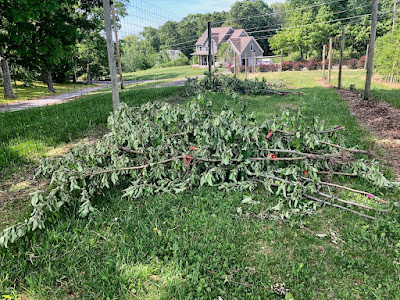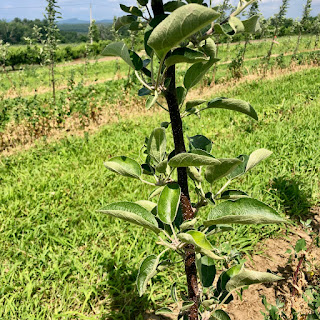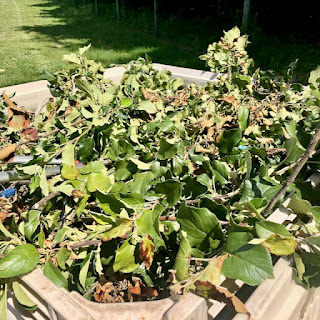In late 2020 Valent Biosciences received Federal registration for ACCEDE plant growth regulator. From their announcement “Accede is the first PGR based on a naturally occurring compound developed specifically for thinning of stone fruit, including peaches and nectarines. It also gives apple growers an effective tool to thin apples in the late thinning window when fruit are 15-20 mm in diameter. Until now, no fruit thinner has provided reliable thinning at this stage of development. Use of Accede will reduce the need for costly hand thinning to adjust the crop load and generate higher fruit quality and grower returns.”
How does Accede work to thin apples and peaches? Accede (active ingredient 1-aminocyclopropane-1-carboxylic acid, ACC) is classified as a naturally occurring “biochemical” plant growth regulator. It is an immediate precursor to ethylene production. Application of Accede thus stimulates ethylene production which in turn triggers seed abortion and the formation of an abcission zone. Hence fruitlet drop (in apples when applied at 15-20 mm fruitlet diameter) and flower senescence (in peaches when applied at bloom) is promoted and accelerated. Application of ethephon can do the same thing, but ethephon is a bit “unpredictable” whereas Accede is a bit “safer.”
At the University of Massachusetts, Duane Greene started experimenting with ACC over 10 years ago. A couple years of trialing at the UMass Orchard in Belchertown on McIntosh apples resulted in significant fruit thinning that increased (less percent fruit set) with rate and with later timing (10 mm vs. 20 mm, Figure 1). He also noted some leaf yellowing/drop after Accede application, but it was not excessive. And Phil Schwallier at Michigan State University in 2016 showed that ACC application increased fruit size of Gala apples to 160 grams per apple compared to 120 grams per apple for untreated trees.
 |
| Figure 1 - 2011 results of ACC research at UMass Orchard (Duane Greene) |
- MDAR notified in writing prior to application
- Supervised by Cat 49 (Research & Demonstration) applicator
- Public access limited by signage “Notice Pesticide Testing”
- Report submitted to MDAR at conclusion of EUP
With enough Accede on hand in the spring of 2021 to cover about five acres total, I solicited four Massachusetts orchards – one in the northeast, two in central Massachusetts, and one west of the Connecticut River – to use Accede under the EUP. I also intended to use Accede at the UMass Orchard in Belchertown. Along with Jim Wargo, Valent sales rep for New England and New York, visits were made to the orchards in late May to assess the need for further thinning after they had already applied their petal fall and 10 mm chemical thinners (Fig. 2). It was not too hard to settle on approximately one-half to one acre apple blocks where additional thinning was desired at 15-20 mm fruitlet size.
 |
| Figure 2 - Accede EUP application discussion with Jim Wargo (Valent USA) on 25-May, 2021 |
Valent supplied the directions for the growers to use when applying Accede under the EUP, including:
- Use a rate of 200-400 ppm (23-46 fl oz/A) at 15-20 mm fruitlet diameter
- Use a non-ionic surfactant at 0.05% v/v (6.5 fl oz/100 gal)
- Use 100 gallons per acre (adequate coverage of fruit and foliage)
- DO NOT apply as tank mix partner with other thinning products
- Consider reduced rate if temperatures predicted to exceed 90 F. on day of application
- And allow 7-10 days to observe effect of thinning
Growers were instructed to follow these directions the best they could, and applications were made around June 1. I should note that the NEWA Apple Carbohydrate model indicated a moderate deficit would be occurring shortly after most applications were made, so we expected to get some (good) results. Accede was applied to quite a few varieties, including Gala, Honeycrisp, Fuji, McIntosh, Cortland, Macoun, Golden Delicious, and Paulared (among a few others). Growers noted there were no particular problems mixing and applying Accede and most used LI-700 as the surfactant. The rate of Accede used was 300 to 400 ppm in 50 to 100 gallons of water. With the exception of Paulared and one Macoun block being larger trees, the rest of the blocks were smaller (150 gallons per acre dilute tree row volume approximately) but mature bearing trees on dwarfing rootstocks.
A few weeks following the Accede applications, a visit was made to each orchard to visually assess the efficacy (or not) of the Accede application(s). Valent provided a form that included the assessment parameters of leaf yellowing/drop, tree vigor, thinning activity, and return bloom (Fig. 3).
 |
| Figure 3 - Portion of assessment form provided by Valent to assess ACC applications |
When assessments were complete, it was agreed that leaf yellowing-drop ranged from none to moderate, while tree vigor was generally good (slight reduction in canopy density) to excellent (no difference in tree canopy vs. untreated). Thinning activity varied widely by orchard and variety. As a general rule, Golden Delicious types (like Gala) were sufficiently thinned compared to the untreated control (Figs. 4 and 5) where little or no hand thinning was needed. McIntosh types seemed largely unfazed by the Accede application(s) though. This was also observed in an ACC experiment conducted on McIntosh by Greene where virtually no thinning occurred too. On Honeycrisp, it’s unclear how Accede may work, it may be useful there but still to be determined.
 |
| Figure 3 - Gala fruitlet drop following Accede application: untreated control on left vs. Accede application on right |
 |
| Fig. 5 - Typical Gala fruitlet clusters after Accede application: untreated control on left, Accede application on right |
We are learning how Accede may be another useful chemical thinner in your toolbox but don’t count on it being a silver bullet. Plan on starting chemical thinning early and often just as usual, and then bring out the Accede if you get to the point when fruitlets are 15-20 mm in size and you are looking at having to do considerable hand thinning still. Accede will probably not be a good option at the 10 mm fruit size, but that is still being evaluated. Having some carbohydrate deficit on the trees during the timing of Accede application will be helpful, and Accede may be particularly useful on Gala to increase thinning and improve apple size.
I alluded to the fact that Accede can also be used for thinning stone fruit, including peaches! That is a big deal as we don’t have a chemical thinner for peaches. And it’s a very promising thinner of peaches. For example, a summary of Accede EUP applied to peaches in 2021 in New York, Michigan, Ohio, and Pennsylvania across many peach varieties resulted in an average fruit reduction of 39% compared to the untreated control (Gregory Clarke, Valent USA). Peach varieties did vary quite widely in their thinning response to Accede, but that might have been a location effect. And in Michigan, work by Anna Wallis and Phil Schwallier in 2021 showed that hand thinning time was reduced by approximately 50% with Accede application compared to non-treated peaches. That would be sweet!
New York already has a state registration for Accede, on both apples and stone fruit, but as of late 2021 not all the New England states had Accede registered, including Massachusetts (per CDMS Advanced Label Search, which I really don't like, prefer Agrian, but Accede not listed there yet!). All state registrations, however, are expected in 2022. But I have learned that Accede supply for 2022 may be somewhat limited, and Valent plans to expand a demo program similar to what was done in 2021. Reach out to your agrochemical supplier if you want to use Accede in 2022, particularly if you want to trial it on some peaches.
Thanks to Parlee Farms, Carlson Orchards, Ragged Hill Orchard, and Clark Brothers Orchard for participating in the EUP. And to Jim Wargo and Greg Clarke of Valent for supporting the EUP in more ways than one. And Duane Greene for his preliminary work with ACC and for some worthy edits to the text herein...











































